英国文学ppt课件
合集下载
英国文学TheAngloSaxonPeriod ppt课件
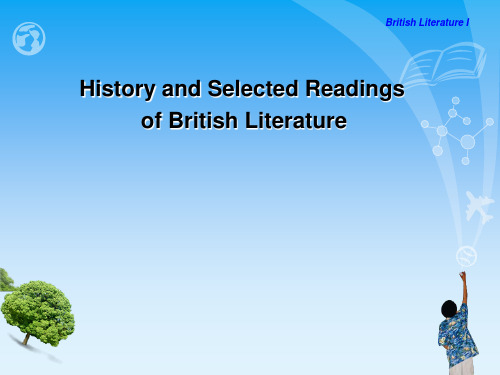
The Anglo-Saxon Period witnessed a Transition from tribal society to feudalism.
British Literature I
5. The Anglo-Saxon religious belief
The Anglo-Saxons were heathen (异教徒) people, believing in old mythology of Northern Europe.
Early Inhabitants
Britons
Britain
a tribe of Celts the land of Britons
primitive people clustering of huts
tribal society
2. The Roman Conquest
British Literature I
British Literature I
History and Selected Readings of British Literature
British Literature I
Outline of British Literature
▪ 1. Anglo-Saxon Period 盎格鲁-撒克逊时期(449-1066) ▪ 2. Anglo-Norman Period (Middle Ages)盎格鲁- 诺曼时期
English language was influenced by the Northern mythology.
▪ 6.The Romanticism浪漫主义时期(1798-1832) ▪ 7.The Critical Realism 批判现实主义时期(19世纪30年代-
英国文学史莎士比亚简介ppt课件
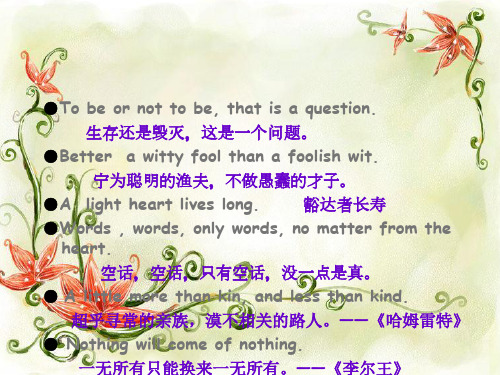
超乎寻常的亲族,漠不相关的路人。——《e of nothing.
一无所有只能换来一无所有。——《李尔王》
病原体侵入机体,消弱机体防御机能 ,破坏 机体内 环境的 相对稳 定性, 且在一 定部位 生长繁 殖,引 起不同 程度的 病理生 理过程
He was an English poet and playwright, widely regarded as the greatest writer in the English language and the world's pre-eminent dramatist.
病原体侵入机体,消弱机体防御机能 ,破坏 机体内 环境的 相对稳 定性, 且在一 定部位 生长繁 殖,引 起不同 程度的 病理生 理过程
poetry
In his creation of dramas, he succeeded in combing the two sides of his talent— Shakespeare the poet and Shakespeare the dramatist—into one and produced the most remarkable poetic dramas in England or perhaps in the whole world.
•哈姆雷特Hamlet
•克劳狄斯Claudius
病原体侵入机体,消弱机体防御机能 ,破坏 机体内 环境的 相对稳 定性, 且在一 定部位 生长繁 殖,引 起不同 程度的 病理生 理过程
乔特鲁德Gertrude 哈姆莱特之母 奥菲利亚Ophelia 波洛涅斯之女
病原体侵入机体,消弱机体防御机能 ,破坏 机体内 环境的 相对稳 定性, 且在一 定部位 生长繁 殖,引 起不同 程度的 病理生 理过程
《英国浪漫主义文学》课件

历史背景
哲学思考
英国浪漫主义文学作品中常常包含深 刻的哲学思考,探讨人性、道德、自 由等主题,表现出对人类命运的关注 和思考。
英国浪漫主义文学关注历史背景,将 文学作品与历史事件、社会现实等联 系起来,展现出浓厚的历史感。
05
英国浪漫主义文学的影响与评价
对世界文学的影响
01
丰富了世界文学的多样性
作品风格
现实主义与浪漫主义相结合, 注重细节描写和人物塑造
晚期浪漫主义
时间范围
1830年-1860年
特点
关注人性探索,深入挖掘内心世界,强调个 性表达
代表人物
丁尼生、布朗宁、梅尔维尔等
作品风格
心理分析、象征主义和神秘主义,注重艺术 表现和情感渲染
03
英国浪漫主义文学的主要代表人 物及其作品
威廉·布莱克
诗歌形式与技巧
诗歌形式
英国浪漫主义诗歌形式多样,包 括长诗、短诗、叙事诗等,强调 韵律和节奏感。
象征与隐喻
英国浪漫主义诗歌善于运用象征 和隐喻手法,通过具象的描绘传 达抽象的概念和情感。
情感渲染
英国浪漫主义诗歌注重情感渲染 ,通过强烈的情感表达和渲染来 打动读者。
自然与人文的融合
பைடு நூலகம்
自然描绘
英国浪漫主义作家善于描绘自然,将 自然元素融入到作品中,强调人与自 然的和谐共存。
01
时间范围
1789年-1800年
02
03
04
代表人物
拜伦、雪莱、济慈、华兹华斯 等
特点
强调个人情感、自然和自由, 反对理性主义和传统束缚
作品风格
富有想象力,追求形式和语言 的创新
中期浪漫主义
时间范围
【最新】英国文学ppt课件

2021/2/2
An Introduction to British and American Culture
Charles Dickens (1812-1870)
佳句赏析 “It was the best of times, it was the worst of times, it was the age of wisdom, it was the age of foolishness, it was the epoch of belief, it was the epoch of incredulity…” 这是最好的时代,这是最坏的时代;这是智慧 的时代,这是愚蠢的时代;这是信仰的时期, 这是怀疑的时期……”
2021/2/2
An Introduction to British and American Culture
English Novel
Daniel Defoe (1660-1731)
Robinson Crusoe describes how Crusoe makes great efforts to overcome the hardships and difficulties he encounters on the island. . .
Three famous plays : 1.Tamburlaine (1587) 《帖木耳大帝》 2.The Jew Of Malta (1592) 《马耳它的犹太人》 3.The Tragical History of Dr. Faustus (1588)
《浮士德博士的悲剧》
2021/2/2
An Introduction to British and American Culture
第九讲十七世纪英国文学ppt课件

☆ 关于《失乐园》的争议
1、“撒旦派”:强调撒旦是作品的主人公,认为他是具有大无畏精神的
革命者的象征——政治诗歌
2、“正统派”:倾向于从宗教角度来做解释,认为作品主要表现人类如
何失去上帝的恩宠而堕落——宗教诗
3、“调和派”:调和前两派观点,认为史诗存在着双层人物、双层结构
撒旦:正义——非正义 上帝:反面形象——走向正面 人类:自身弱点造就不幸——理性照耀未来
——魔鬼撒旦反抗上帝,设计陷害人类 ——亚当与夏娃受诱惑,被逐出伊甸园
☆ 史诗内容(共12章)
第1部:全诗总纲,讲述了整个事件的起因和结果; 第2部:撒旦与众叛逆天使讨论如何同上帝作战,夺取天堂; …… 第4部:描述撒旦在天堂见到亚当和夏娃,撒旦在夏娃的梦中施展引诱; …… 第6部:描绘天使与撒旦一伙的战斗; …… 第9部:撒旦化身为蛇,躺在伊甸园里,并指引亚当和夏娃偷食禁果; …… 第12部:天使向他们叙述拯救之路,亚当和夏娃终于离开天堂,失去了乐园
让我们把所有力气,所有 甜蜜,滚成一个圆球,
粗鲁狂猛地夺取我们的快感 冲破一扇扇人生的铁栅栏:
这样,我们虽无法叫太阳 驻足,却可使他奔跑向前。
2、约翰·弥尔顿
(1)John Milton , 1608-1674
弥尔顿人生的三个阶段:
1、(1608-1639)求学、隐居、游历, 写作了一些短小的诗歌;
一、十七世纪英国文学分类与分期
1、分类——
☆ 新古典主义文学 法国古典主义影响与英国王权复辟现实结合的产物 文艺理论是其主要成就
☆ 资产阶级革命文学 文艺复兴时期人文主义的发展 资产阶级清教革命的产物 成就主要是史诗
2、分期——
a、前期
(1)资产阶级革命文学——弥尔顿
英国文学 讲解Sonnet PPT课件

在此诗的基本音步类型是抑扬格,每行五音步。因此 称此诗的格律是“抑扬格五音步”(iambic pentameter)。一首诗的音步类型和诗行所含的音步 数目构成此诗的格律(meter)。
第9页/共53页
Hamlet
Old words:
• Thee, obj.,
thou, sub.,
thy=your, thine=yours, or
第11页/共53页
Hamlet
Old words:
• Ere=before still=always oft=often Happily=haply=perhaps even=evening
第12页/共53页
6. Text Study: Sonnet 18
可否把你比作美丽的夏天? 可你比夏天更加可爱如绣: 狂风摇曳着五月里的花冠, Shall I compare thee to a summer ’s d夏ay天? 的租期不肯太长逗留,
有时候苍之巨眼未免焦灼, 他金色的脸也会经常暗退。 所有的美丽总会不免衰落, 偶然或永恒总将美丽残催。
第14页/共53页
But thy eternal summer shall not fade,
But your youth shall not fade, Nor lose possessioNnoorf wthiallt yfaoiur tlohoseu tohwe’bseta; uty that you possess; Nor shall Death brNagorthwoiullwdaenadtherc’lastimin yhoisu sfhoardhei,s own, When in eternal linBeesctaoustiemien tmhoyuegterornwa’l svte; rse you will live forever.
第9页/共53页
Hamlet
Old words:
• Thee, obj.,
thou, sub.,
thy=your, thine=yours, or
第11页/共53页
Hamlet
Old words:
• Ere=before still=always oft=often Happily=haply=perhaps even=evening
第12页/共53页
6. Text Study: Sonnet 18
可否把你比作美丽的夏天? 可你比夏天更加可爱如绣: 狂风摇曳着五月里的花冠, Shall I compare thee to a summer ’s d夏ay天? 的租期不肯太长逗留,
有时候苍之巨眼未免焦灼, 他金色的脸也会经常暗退。 所有的美丽总会不免衰落, 偶然或永恒总将美丽残催。
第14页/共53页
But thy eternal summer shall not fade,
But your youth shall not fade, Nor lose possessioNnoorf wthiallt yfaoiur tlohoseu tohwe’bseta; uty that you possess; Nor shall Death brNagorthwoiullwdaenadtherc’lastimin yhoisu sfhoardhei,s own, When in eternal linBeesctaoustiemien tmhoyuegterornwa’l svte; rse you will live forever.
英国文学简史-18th-century(1)PPT课件
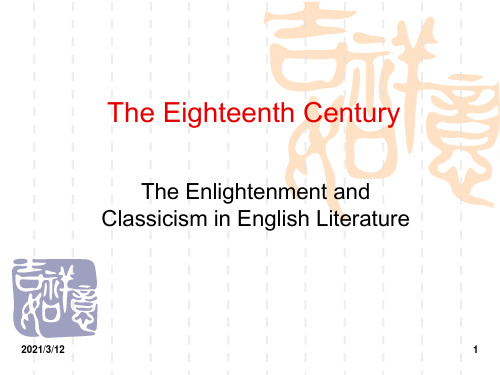
emphasis on the imagination, on invention and experimentation
man as an imperfect being, inherently sinful, whose potential was limited.
emphasis on order and reason, on restraint, on common sense
Enlightenment Movement
The England Enlightener (P127)
2021//12
2
The 18th Century England
comparatively peaceful development
In politics
a constitutional monarchy
2021/3/12
11
Dissimilarities in Point of View
man as a being fundamentally good and possessed of an infinite potential for spiritual and intellectual growth.
2021/3/12
5
The Features of English Enlightenment
▪ (1)English enlighteners believed in the power of reason. That is why the 18th century has often been called “the age of reason” or “the kingdom of reason”.
3
man as an imperfect being, inherently sinful, whose potential was limited.
emphasis on order and reason, on restraint, on common sense
Enlightenment Movement
The England Enlightener (P127)
2021//12
2
The 18th Century England
comparatively peaceful development
In politics
a constitutional monarchy
2021/3/12
11
Dissimilarities in Point of View
man as a being fundamentally good and possessed of an infinite potential for spiritual and intellectual growth.
2021/3/12
5
The Features of English Enlightenment
▪ (1)English enlighteners believed in the power of reason. That is why the 18th century has often been called “the age of reason” or “the kingdom of reason”.
3
英国文学维多利亚时期全集ppt课件

❖ (2) Background: developed rapidly both politically & economically (capitalism first took shape, agricultural to industrial society
❖ The Early Victorian Period (1832-1848)
Chapter III Victorian Novels
❖ the novel became the dominant genre
❖ Plot is unfolded against a social background
❖ “linear causation”: cause-effect sequence
❖ The worsening living & working conditions, the mass unemployment & the new Poor Law of 1834 finally gave rise to the Chartist Movement (1836-1848).
❖ They offer a most complete & realistic picture of English society of his age & remain the highest achievement in the 19thcentury English novel.
❖ In nearly all his novels, behind the gloomy pictures of oppression & poverty, behind the loud humor & buffoonery 滑稽, is his gentleness, his simple faith in mankind.
《英国文学简介》课件

3
文艺复兴时期文学
莎士比亚的戏剧和斯宾塞的史诗,代表了英国文艺复兴时期的顶峰成就。
18世纪文学
启蒙时代文学
以强调理性和人权为特点,代表作品包括斯威夫特 的《格列佛游记》。
浪漫主义文学
通过追求自然、个人情感和幻想,让艺术与内心相 互融合,如拜伦的诗歌作品。
罗曼主义文学
文学流派 诗歌 小说 戏剧
代表作家 威廉·华兹华斯、塞缪尔·柯勒律治 简·奥斯汀、勃朗特姐妹 威廉·莎士比亚
现代主义文学
特征
反叙述、流派混合、内心意识流的表达方式,如弗 吉尼亚·伍尔夫的《到灯塔去》。
代表作家
T.S.艾略特、詹姆斯·乔伊斯、维吉妮亚·伍尔夫。
当代文学
文学派别
后现代主义、魔幻现实主义、 女性文学、后殖民文学等。
重要作家
伊恩·麦克尤恩、朱利安·巴恩 斯、萨尔曼·鲁西迪。
全球影响
当代英国文学作品在全球范 围内受到广泛关注,引领潮 流并触及世界共同话题。
《英国文学简介》
本PPT课件将带领大家一起探索英国文学的丰富历史和重要作家,以及各个时 期的文学流派和风格。
英国rse
英国文学拥有丰富多样的作品,从古代到现代,涵盖了各种题材和风格。
2 Influential and Enduring
英国文学对世界文学产生了深远的影响,作品在多个国家和文化中广为传播与研究。
3 Reflecting Society
英国文学作品引人深思,反映了当时社会的价值观、文化特征和历史背景。
英国文学史
1
古英语文学
从盎格鲁-撒克逊时期的《贝奥武夫》到中世纪的传说故事,古英语文学充满古 老而神秘的魅力。
2
中世纪文学
John_Milton弥尔顿 英国文学 ppt课件
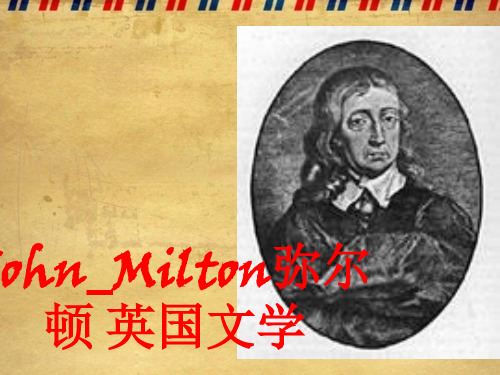
pamphlets • 3.the great poem • 4.sonnets
John_Milton弥尔顿 英国文学
• L‘Allegre 《快乐的人》 • IL Pens eroso (1632) 《忧思的人》
John_Milton弥尔顿 英国文学
• Areopagitica《论出版自由》
• The Tenure of Kings and Magistrates
He met famed scholar Hugo Grotius in Paris, then to Italy.
Milton arrived in Florence, where he met with Galileo(伽利 略).
In Rome, he was a guest of Cardinal , and visited the Vatican(梵蒂冈) Library.
gave up being a clergyman to his father’s country house
6 years of private study and poetry writing
John_Milton弥尔顿 英国文学
• 1638-1639 A tour to France and Italy • The summer of 1639 Return
Of Reformation 《论改革》, Animadversions 《批判》, and Of Prelatical Episcopacy 《论主教制》
His Marriage
•Married three times •Had four children • strain relationships •Mary Powell •Desertion •"Milton the Divorcer"
John_Milton弥尔顿 英国文学
• L‘Allegre 《快乐的人》 • IL Pens eroso (1632) 《忧思的人》
John_Milton弥尔顿 英国文学
• Areopagitica《论出版自由》
• The Tenure of Kings and Magistrates
He met famed scholar Hugo Grotius in Paris, then to Italy.
Milton arrived in Florence, where he met with Galileo(伽利 略).
In Rome, he was a guest of Cardinal , and visited the Vatican(梵蒂冈) Library.
gave up being a clergyman to his father’s country house
6 years of private study and poetry writing
John_Milton弥尔顿 英国文学
• 1638-1639 A tour to France and Italy • The summer of 1639 Return
Of Reformation 《论改革》, Animadversions 《批判》, and Of Prelatical Episcopacy 《论主教制》
His Marriage
•Married three times •Had four children • strain relationships •Mary Powell •Desertion •"Milton the Divorcer"
英国经典文学著作《月亮与六便士》小说鉴赏学生阅读技巧提升培训讲座PPT模板课件

主题思想
THEME
OF
NOVE L
主题思想
“毛姆以高更为灵感所写的小说《月 亮和六便士》,毫无疑问杜撰超过事 实。“在接下来的十年里,高更认为 他最终能够享受成功的果实,让一家 人团圆。”对比小说与现实可以发现
就塑造了一位不通人情世故和不食人 间烟火的所谓纯粹意义上的艺术家。 比起高更的出走,主人公斯特里克兰 德的出走完全不符合现实的逻辑
主要人物
思特里克兰德太太在20世纪初都是生逢其 时。她出身于英国世家,结交社会名流, 举手投足端庄典雅,完全符合上流社会所 要求的女性风范。她面容和蔼可亲,衣着 大方得体,家居布置淡雅别致
这样一位近乎完美的女性有一个致命的弱 点,她完全不了解、不理解自己的丈夫却 自以为如此。思特里克兰德太太曾满含爱 意地对“我”谈起她丈夫:“他一点文学 修养也没有,是个十足的小市民。”
主要人物
思特里克兰德
思特里克兰德原本是证券经纪人,在他那张 粗野的,显着肉欲的脸的背后,有着一颗骚 动而不安的心,他饱受孤独的摧残,经受来 自“神”的折磨,而他又是天生为艺术而生 的人,所以,他在驱之不散的念头的驱使下, 在时间不在场的诱惑下,冲出世俗的樊篱, 走向了艺术的至境。他正是在孤独中仿徨, 在孤独中冲突,在孤独中生成,在生命的最 后一瞬间,在孤独中实现了灵魂的自由。
爱
塔
爱塔是塔希提岛当地土著居民,她在塔拉窝 河旁有一小块地产,她很节俭,把在鲜花旅 店帮工挣的钱都攒了起来,她不在乎那些繁 文缚节,非常通情达理,她不要求当着市长 的面举行什么仪式,这并不意味着她是个没 人娶的姑娘:她很漂亮,也很自爱,从不跟 人乱来,她做这一切仅仅因为她喜欢思特里 克兰德。与前面二桩婚姻的貌合神离相比, 他们的婚姻生活简单而幸福。
The English Renaissance英国文学PPT教学课件
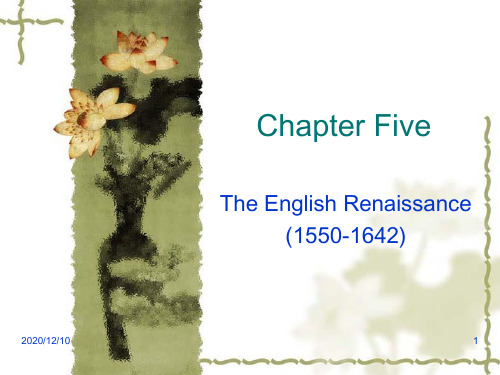
❖ Ideal of Renaissance: Humanism.
❖ In 1453,the Turks seized Constantinople.
❖ The Englishmen who studied in Italy brought the new learning back with them to the monasteries at Oxford and Cambridge and from there Greek and Roman culture were spread to other places.
2020/12/10
Chapter Five
The English Renaissance (1550-1642)
1
Historical Background
❖ The reign of Queen Elizabeth(1588-1603)— peace and prosperity
❖ English navy defeated Spanish Armada in 1588, and became a mighty naval power.
2020/12/10
3
Humanism
❖ So many brilliant writers worked at the same time.
❖ The literary movement began in the 14th century in Italy and later spread to France, Spain, the Netherlands, and England.
❖ The first modern drama, however, was not performed by professionals, not by guilds, as in the case of the miracle plays—Ralph Royster Doyster.
❖ In 1453,the Turks seized Constantinople.
❖ The Englishmen who studied in Italy brought the new learning back with them to the monasteries at Oxford and Cambridge and from there Greek and Roman culture were spread to other places.
2020/12/10
Chapter Five
The English Renaissance (1550-1642)
1
Historical Background
❖ The reign of Queen Elizabeth(1588-1603)— peace and prosperity
❖ English navy defeated Spanish Armada in 1588, and became a mighty naval power.
2020/12/10
3
Humanism
❖ So many brilliant writers worked at the same time.
❖ The literary movement began in the 14th century in Italy and later spread to France, Spain, the Netherlands, and England.
❖ The first modern drama, however, was not performed by professionals, not by guilds, as in the case of the miracle plays—Ralph Royster Doyster.
英国浪漫主义时期文学PPT课件

• (7) Lyrical Ballads, 《抒情歌谣集》 a collection of poem by William Wordsworth and Samuel Taylor Coleridge, published in 1798, which marked the start of Romanticism as a literary trend.
Revolution exert great influence on English
Romanticism.
4
• Romanticists show in their works their profound dissatisfaction with the social reality and their deep hatred for any political tyranny, economic exploitation and any form of oppression, feudal or bourgeois. In the realm of literature, they revolt against reason, rules, regulation, objectivity, common senses, etc. and emphasize the value of feelings, intuition, freedom, nature, subjectivism, individuality, originality, imagination, etc.
• English Romanticism is a revolt of the
English imagination against the
neoclassical reason. The French Revolution
Revolution exert great influence on English
Romanticism.
4
• Romanticists show in their works their profound dissatisfaction with the social reality and their deep hatred for any political tyranny, economic exploitation and any form of oppression, feudal or bourgeois. In the realm of literature, they revolt against reason, rules, regulation, objectivity, common senses, etc. and emphasize the value of feelings, intuition, freedom, nature, subjectivism, individuality, originality, imagination, etc.
• English Romanticism is a revolt of the
English imagination against the
neoclassical reason. The French Revolution
外教社2024新编英国文学史教程PPT课件 Unit 6
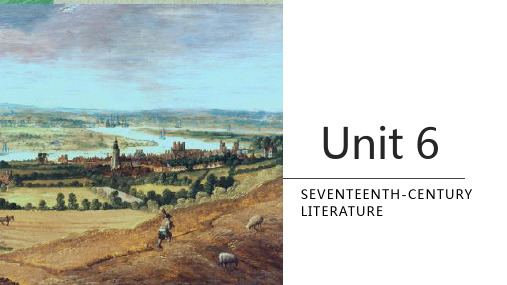
Key Words
Skepticism
Insufficient evidence to support religious claim Political turbulences staged the unresolved paradox between faith and reason.
Key Words
setting shape our interpretation of the work?
2. What are the features of Neoclassicism?
Writers and Works
John Bunyan (1628-1688)
1. Enlisted in the Parliamentary army and served in the English Civil War
Interpretation:
Paradise Lost
1. The story 2. The character of Satan
The Epic Style and Milton’s Political Standing
Satan Arousing the Rebel Angels William Blake (1808)
e.g. love, books, truth…
2. Testify arguments
“to try” or “to attempt”, to analyze with logic
Questions for Critical Thinking
1. Why did Bacon write most of his works in Latin but Essays in English?
英国文学盎格鲁撒克逊时代ppt课件
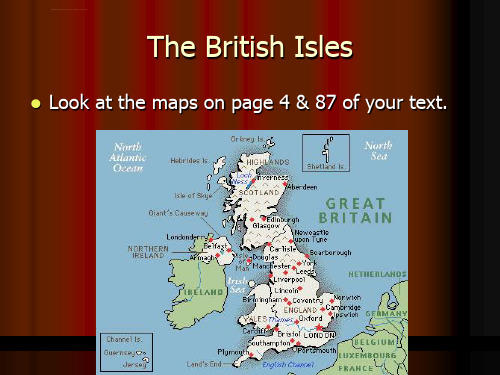
gods and people Ritual dances, rites: Stonehenge?
篮球比赛是根据运动队在规定的比赛 时间里 得分多 少来决 定胜负 的,因 此,篮 球比赛 的计时 计分系 统是一 种得分 类型的 系统
Celtic Mythology
Arthur – legendary Celtic warrior; became embodiment of English values (Sir Thomas
Anglo-Saxon Success
Fame and success gained only through LOYALTY to the leader
Success measured in gifts from the leader
篮球比赛是根据运动队在规定的比赛 时间里 得分多 少来决 定胜负 的,因 此,篮 球比赛 的计时 计分系 统是一 种得分 类型的 系统
green
dotted with thatched cottages, quaint stone churches, and mysterious stone ruins
篮球比赛是根据运动队在规定的比赛 时间里 得分多 少来决 定胜负 的,因 此,篮 球比赛 的计时 计分系 统是一 种得分 类型的 系统
The Anglo-Saxon Period
449-1066
篮球比赛是根据运动队在规定的比赛 时间里 得分多 少来决 定胜负 的,因 此,篮 球比赛 的计时 计分系 统是一 种得分 类型的 系统
Ancient World
isolated
rain-drenched and often fogged in
Woden (Woden’s Day: Wednesday) Dragon: significant figure; guardian of the grave,
篮球比赛是根据运动队在规定的比赛 时间里 得分多 少来决 定胜负 的,因 此,篮 球比赛 的计时 计分系 统是一 种得分 类型的 系统
Celtic Mythology
Arthur – legendary Celtic warrior; became embodiment of English values (Sir Thomas
Anglo-Saxon Success
Fame and success gained only through LOYALTY to the leader
Success measured in gifts from the leader
篮球比赛是根据运动队在规定的比赛 时间里 得分多 少来决 定胜负 的,因 此,篮 球比赛 的计时 计分系 统是一 种得分 类型的 系统
green
dotted with thatched cottages, quaint stone churches, and mysterious stone ruins
篮球比赛是根据运动队在规定的比赛 时间里 得分多 少来决 定胜负 的,因 此,篮 球比赛 的计时 计分系 统是一 种得分 类型的 系统
The Anglo-Saxon Period
449-1066
篮球比赛是根据运动队在规定的比赛 时间里 得分多 少来决 定胜负 的,因 此,篮 球比赛 的计时 计分系 统是一 种得分 类型的 系统
Ancient World
isolated
rain-drenched and often fogged in
Woden (Woden’s Day: Wednesday) Dragon: significant figure; guardian of the grave,
外教社2024新世纪新编英国文学史教程 PPT课件unit 4
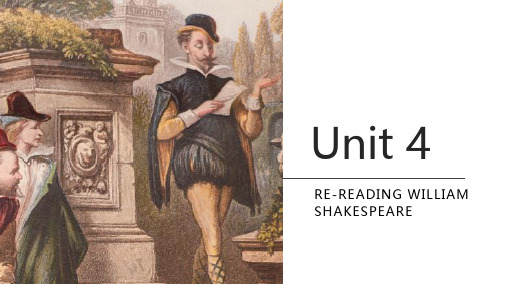
3. Seneca’s Influence Soliloquies & supernatural elements
Interpretation: Hamlet
1. The story
2. Meta-Theatre in Hamlet
Play-within-play, long soliloquies of the tragic hero, curse on pretention of women, the acting and scrip-writing for the role courtiers play, and the staging of revenge to restore justice
Re-Interpretating Shakespeare Re-Interpretating Shakespeare
Re-Interpretating Shakespeare
“The Outsiders” in Shakespeare’s Plays
Racial, national, religious, and cultural difference
Re-Interpretating Shakespeare
Staging Shakespeare
Modern-dress production
Staging Shakespeare in historical or political setting
✏︎ Introduce one adaption of Shakespeare’s play.
2. Why was Shylock in The Merchant of Venice the focus of the play in
Interpretation: Hamlet
1. The story
2. Meta-Theatre in Hamlet
Play-within-play, long soliloquies of the tragic hero, curse on pretention of women, the acting and scrip-writing for the role courtiers play, and the staging of revenge to restore justice
Re-Interpretating Shakespeare Re-Interpretating Shakespeare
Re-Interpretating Shakespeare
“The Outsiders” in Shakespeare’s Plays
Racial, national, religious, and cultural difference
Re-Interpretating Shakespeare
Staging Shakespeare
Modern-dress production
Staging Shakespeare in historical or political setting
✏︎ Introduce one adaption of Shakespeare’s play.
2. Why was Shylock in The Merchant of Venice the focus of the play in
《英国文学选读》课件

和世界的思考。
通过阅读英国文学作品,可以培 养个人的审美观念、批判思维和
创造力,提升个人综合素质。
英国文学作品中所描绘的人物形 象和故事情节,有助于引导个人 树立正确的价值观、人生观和世
界观。
对社会观念的反思
英国文学作品反映了社会历史的变迁 和人类文明的进步,促使人们对社会 问题进行深入反思。
英国文学作品中对社会问题的揭示和 批判,有助于激发人们对社会正义和 进步的思考,推动社会变革和进步。
,关注其思想内涵和人文精 神,了解当时的社会变革和
文化思潮。
总结词
注重作品的文学技巧和创新
详细描述
探讨中期文学作品所运用的文学技巧和创 新,如何推动文学的发展,以及在文学史 上的贡献。
总结词
关注作品的情感表达和审美追求
详细描述
分析中期文学作品中的情感表达和审美追 求,如何通过情感和审美来表达作品的主 题和思想。
英国文学的价值
英国文学不仅是文化遗产,也是人类智慧的结晶。它提供了对人性、社会和人 类命运的深刻洞察,启发了人们对生活、道德和人性的思考。英国文学作品还 具有很高的审美价值,为读者提供了丰富的阅读体验。
分析当前英国文学的发展趋势
多元化与包容性
当前英国文学的一个显著趋势是 多元化和包容性。越来越多的作 家来自不同背景,关注各种社会 议题,使英国文学更加丰富多彩
03
社会责任与担当
面对当今世界的挑战,未来的英国文学将更加注重社会责任和担当。作
家们将通过他们的作品关注环境保护、社会公正和人权等议题,发挥文
学在社会问题上的舆论引导和思考启迪的作用。
THANKS
感谢观看
通过阅读英国文学作品,可以了解不 同社会背景和文化传统下人们的思想 观念和行为方式,促进跨文化交流和 理解。
通过阅读英国文学作品,可以培 养个人的审美观念、批判思维和
创造力,提升个人综合素质。
英国文学作品中所描绘的人物形 象和故事情节,有助于引导个人 树立正确的价值观、人生观和世
界观。
对社会观念的反思
英国文学作品反映了社会历史的变迁 和人类文明的进步,促使人们对社会 问题进行深入反思。
英国文学作品中对社会问题的揭示和 批判,有助于激发人们对社会正义和 进步的思考,推动社会变革和进步。
,关注其思想内涵和人文精 神,了解当时的社会变革和
文化思潮。
总结词
注重作品的文学技巧和创新
详细描述
探讨中期文学作品所运用的文学技巧和创 新,如何推动文学的发展,以及在文学史 上的贡献。
总结词
关注作品的情感表达和审美追求
详细描述
分析中期文学作品中的情感表达和审美追 求,如何通过情感和审美来表达作品的主 题和思想。
英国文学的价值
英国文学不仅是文化遗产,也是人类智慧的结晶。它提供了对人性、社会和人 类命运的深刻洞察,启发了人们对生活、道德和人性的思考。英国文学作品还 具有很高的审美价值,为读者提供了丰富的阅读体验。
分析当前英国文学的发展趋势
多元化与包容性
当前英国文学的一个显著趋势是 多元化和包容性。越来越多的作 家来自不同背景,关注各种社会 议题,使英国文学更加丰富多彩
03
社会责任与担当
面对当今世界的挑战,未来的英国文学将更加注重社会责任和担当。作
家们将通过他们的作品关注环境保护、社会公正和人权等议题,发挥文
学在社会问题上的舆论引导和思考启迪的作用。
THANKS
感谢观看
通过阅读英国文学作品,可以了解不 同社会背景和文化传统下人们的思想 观念和行为方式,促进跨文化交流和 理解。
- 1、下载文档前请自行甄别文档内容的完整性,平台不提供额外的编辑、内容补充、找答案等附加服务。
- 2、"仅部分预览"的文档,不可在线预览部分如存在完整性等问题,可反馈申请退款(可完整预览的文档不适用该条件!)。
- 3、如文档侵犯您的权益,请联系客服反馈,我们会尽快为您处理(人工客服工作时间:9:00-18:30)。
• Green Chapel • First day, a deer; second day, a boar; the third day a fox. A girdle. —〉the Order of Garter 〉 • A true knight should not only dedicate himself to the church but also should possess the virtues of great courage, of fidelity to his promise, and of physical chastity and purity. • It contained several element which prepared for a new culture. • A vivid portrayal of the hero and a fine analysis of his psychology. • A well unified and exciting plot full of climaxes and surprises. • The three hunting scenes and the three bedchamber scenes are closely related with each other. • A mixture of Anglo-Saxon poetry, the musical effect of which depends on the alliterated initial syllables and Frf which depends on the fixed number of accented and unaccented syllables in a verse line. Paragraphs of long alliterative lines of varying length are followed by a single line of two syllables, called “the bob”, and a group of ” four-stressed lines called “the wheel”, i.e., a set of short lines ” forming the concluding part of a stanza.
• 2. The scop also used a figurative language called “kenning”, a metaphor usually composed of two words, which becomes the formula of a special object: “helmet bearer” for “warrior.” • 3. The use of repetition and variation. Same idea expressed more than once by synonyms. • PS: 第4頁第2段第3行經Word自動更正提示以及 維基百科確認,“Ecclesiatical”為印刷錯誤,應 為“Ecclesiastical”。
2. Northumbrian School and Wessex literature
• two highlights in the development of the AngloSaxon literature. • Monasteries and abbeys in the kingdom of Northumbria. • Caedmon in the 7th turned the stories in the Bible into verse form——Paraphrase. Inspired by God. • The Venerable Bede (673-735), wrote in Latin The Ecclesiastical History of the English People from Caesar to 731. It was Bede who told about the story of Caedmon. • The reign of King Alfred (871-899) • First, Latin books into West Saxon dialect. It is said that King Alfred translated the history of Bede. Second, the launching of The Anglo-Saxon Chronicle, from Caesar’s conquest to 1154. ’ • Third, created a style of Anglo-Saxon prose which was not obscure.
1. Chapter One The Anglo-Saxon Period (450 —— 1066)
• • • • 1. Historical background The Celts 〉the Brythons. The Iron Age. The ceremonies of May dayand the cult of mistletoe. • From 55 BC to 407 AD,the Roman Empire, a slave society. • London was founded. • Little influence on the cultural life of the CeltTown with names ending in “chester” or “caster”.s,
3. Anglo-Saxon poetry
• • • • • • • • • • • • • • • The earliest is Widsith and the last is Maldon. Beowulf As early as the 6th in oral form Written down in the 8th. The manuscript preserved dates back to the 10th and in Wessex dialect. One datable fact in the poem is a raid on the Franks by Gelac in 520. 3183 lines. Danish King Hrothgar built a hall called Heorot. Grendel for 12 years. Beowulf, nephew to King Hygelac of the Geats. With 14 companions. Hrothgar's friend Aeschere killed by Grendel's mother. Killing Grendel’s mother with a magic sword in the cave. ’ One of the 12 companions, Wiglaf, helped Beowulf kill the dragon. Physical strength demonstrates his high spiritual qualities. A mixture of paganism and Christian elements.
• De Bello Gallico by Julius Caesar and Germania by Publius Cornelius Tacitus • 450 AD, the Angles, Saxons, and Jutes. • “angul” means a hook; “seax” means a short ” ” sword. • Around 500 AD, the Celtic King Arthur fought against Cerdic, the founder of the kingdom of Wessex. Camelot, King Arthur’s capital. ’ • Later 8th, the Danes, or the Vikings. King Alfred the Great of Wessex (849-899) • Harold, the last Saxon King 〉William the Duke of Normandy. 597, Pope Gregory the Great sent St. Augustine to England and the first converted king was King Ethelbert of Kent.
2. Chapter Two The Norman Period (1066-1350)
1. Historical background • 1066, the battle of Hastings • The Normans, also descendants of Scandinavian marauders, having seized a wide part of northern France. • Accelerated the feudalism in England. • Large tracts of land by the king, barons, knights and the church. • A peasant uprising in 1381. 2. Middle English • For 3 centuries after the Norman conquest, two languages were used side by side in England: Latin and French. • Words and expressions from Latin and French and Greek in the 14th. • Inflectional forms dropped and grammar simplified. 3. Religious literature • The issue of personal salvation. • Moral and spiritual responsibilities of individual rather than his ethical and social responsibilities. • Conventional theme: homiletic paraphrases of the Gospels
